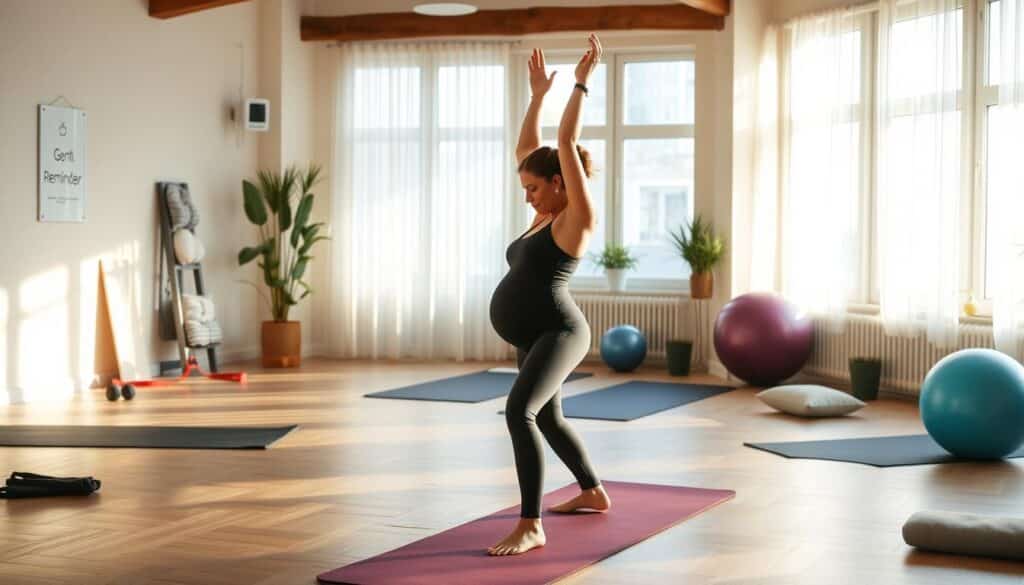Being pregnant brings both joy and challenges. One thing that’s always important to me is staying active. This is good for me and my baby. So, I’m excited to share my guide on safe pregnancy exercises.
When I found out I was pregnant, I wanted to keep exercising. But I learned that some exercises aren’t safe. With the right advice and a bit of creativity, I found ways to stay active and full of energy.
In this guide, we’ll look at the benefits of exercising while pregnant. We’ll also talk about safety tips and suggest workouts for each trimester. This article is for anyone who wants to stay healthy and active during pregnancy.
Key Takeaways
- Exercise during pregnancy offers numerous physical and mental health benefits for both mother and baby.
- It’s important to follow safety guidelines and listen to your body when starting a pregnancy workout routine.
- Prenatal exercises can be tailored to each trimester, focusing on cardiovascular fitness, strength training, and flexibility.
- Maintaining proper form and breathing techniques is crucial for a safe and effective pregnancy workout.
- Consulting with a healthcare provider can help you create a personalized exercise plan that meets your specific needs and stage of pregnancy.
Understanding the Benefits of Exercise During Pregnancy
Being active during pregnancy has many benefits for both mom and baby. It improves physical health and mental well-being. This helps prepare moms for a smoother labor and delivery.
Physical Benefits for Mother and Baby
Prenatal exercise benefits like cardio, strength training, and flexibility exercises are key. They lower the risk of gestational diabetes and back pain. They also boost the baby’s health, leading to better birth outcomes.
Mental Health Advantages
Exercise also boosts a mom’s mental health. It improves mood, reduces stress and anxiety, and helps with sleep. These are all important for a healthy pregnancy.
Preparing for Labor and Delivery
Regular exercise prepares moms for labor and delivery. It strengthens muscles, improves endurance, and teaches breathing techniques. This helps moms handle childbirth more easily and confidently.
Adding a fitness routine to pregnancy brings many benefits. It supports both mom’s and baby’s health. From physical to mental health, the benefits of prenatal exercise are clear.
Safety Guidelines Before Starting Your Pregnancy Workout
As an expectant mother, your safety during pregnancy exercise is key. Always talk to your healthcare provider before starting any workout. They can give you advice that fits your needs and health.
Remember, every pregnancy is different. What works for one woman might not work for another. Know the signs that mean you should stop exercising and see a doctor. These signs include persistent contractions, dizziness, severe headaches, or sudden swelling.
- Consult your healthcare provider before starting any pregnancy exercise program.
- Understand your individual limitations and respect any restrictions from your doctor.
- Be mindful of warning signs, such as persistent contractions or severe headaches, and stop exercising immediately if you experience them.
By following these guidelines, you can safely enjoy pregnancy exercise safety, prenatal workout precautions, and safe pregnancy fitness. Your health and your baby’s health are the most important things. So, be careful and cautious in your fitness journey.
| Recommended Safety Precautions | Potential Risks to Avoid |
|---|---|
| Consult healthcare provider before starting exercise | Overexertion and exhaustion |
| Understand individual limitations and restrictions | Dehydration and heat-related illnesses |
| Be mindful of warning signs and stop exercising immediately | Injuries and complications from high-impact activities |
First Trimester Workout Recommendations
Being active during the first trimester is key for your health. It’s important to listen to your body and adjust as needed. A mix of exercises can keep you feeling great throughout your pregnancy.
Cardiovascular Activities
Try low-impact cardio like walking, swimming, or cycling. These activities boost your mood and energy. Aim for 30 minutes of moderate exercise most days, or do shorter sessions if easier.
Strength Training Basics
Beginners can start with bodyweight exercises or resistance bands. Focus on major muscles like arms, legs, and core. This helps keep muscles toned and prepares your body for labor.
Flexibility Exercises
- Gentle stretching and prenatal yoga ease back pain and muscle tension.
- Choose poses that target hips, hamstrings, and lower back. Modify as needed.
- Regular stretching improves your range of motion, helpful later in pregnancy.
Always check with your healthcare provider before starting new exercises. A variety of safe activities supports your body’s needs and keeps you active during this special time.
| Exercise Type | Recommended Activities | Benefits |
|---|---|---|
| Cardiovascular |
|
Improved endurance, mood, and energy levels |
| Strength Training |
|
Maintained muscle tone, improved posture, and better preparation for labor |
| Flexibility |
|
Reduced discomfort, improved range of motion, and better overall well-being |
Pregnancy Exercises for Core Strength and Stability
As an expectant mother, keeping your core strong is key. Prenatal core exercises help you feel in control, support your baby, and prepare for labor and recovery. Let’s look at some safe and effective abdominal workouts for your pregnancy fitness routine.
Strengthening Your Prenatal Core
You don’t have to stop working out your core just because you’re pregnant. With the right changes, you can keep engaging your abdominal muscles. Here are some safe and effective prenatal core exercises to try:
- Pelvic Tilts: Gently rock your pelvis back and forth, contracting your core muscles as you move. Avoid any crunching or sit-up motions.
- Kegel Exercises: Engage your pelvic floor muscles by squeezing and releasing, helping to support your growing uterus.
- Plank Variations: Try modified planks on your knees or against a wall, focusing on maintaining proper form and breathing.
- Prenatal Yoga Poses: Incorporate gentle yoga poses like cat/cow, child’s pose, and seated twist to strengthen your core while improving flexibility.
It’s crucial to listen to your body and avoid any exercises that cause discomfort or strain. Always check with your healthcare provider or a prenatal fitness specialist to ensure you’re practicing safe abdominal exercises during pregnancy.

Improving Stability and Balance
As your pregnancy progresses, your center of gravity will shift, making stability and balance more challenging. Incorporating pregnancy ab workouts that focus on stabilizing your core can help you maintain good posture, reduce the risk of falls, and prepare your body for the demands of labor and delivery.
- Prenatal Squats: Engage your core while performing controlled, modified squats, keeping your feet shoulder-width apart and your weight in your heels.
- Side-Lying Leg Lifts: Lie on your side, engage your core, and slowly lift your top leg, keeping your hips stacked.
- Banded Abductions: Use a resistance band around your thighs to challenge your core stabilizers as you move your legs out and in.
The key to prenatal core exercises is to listen to your body, start slowly, and gradually increase the intensity as your pregnancy progresses. By focusing on core strength and stability, you’ll be better prepared for the physical demands of pregnancy and childbirth.
Low-Impact Cardio Workouts for Expecting Mothers
As your body changes during pregnancy, finding low-impact cardio exercises is key. These workouts keep you active without hurting your joints. There are many gentle options to help you stay fit and full of energy.
Swimming and Water Aerobics
Prenatal swimming and water aerobics are great for low-impact cardio. The water’s buoyancy eases the pressure on your muscles and joints. This lets you move easily and comfortably.
These activities boost your heart health, muscle tone, and flexibility. Whether you like swimming laps, joining aquatic classes, or just floating, water exercises are refreshing and calming.
Walking and Stationary Cycling
Walking and stationary cycling are simple yet effective low-impact cardio options. Walking is a gentle exercise that’s easy to do indoors or outdoors. It improves blood flow, strengthens your legs, and eases stress.
Stationary cycling offers a low-impact heart workout that you can adjust to your fitness level and energy. It’s a great way to stay active without putting too much strain on your body.
Modified Yoga Poses
Pregnancy yoga is excellent for keeping your body flexible, balanced, and mentally calm. Choose gentle, modified poses that avoid deep twists or backbends. Prenatal yoga strengthens your core, improves your posture, and promotes relaxation.
It keeps your heart rate safe for you and your baby. Always talk to your healthcare provider before starting any new exercise program during pregnancy. They can help you find a safe and effective low-impact cardio routine that fits your needs and preferences.
Warning Signs to Stop Exercising
As an expecting mother, it’s key to listen to your body. You should know when to stop your prenatal workouts. Pregnancy changes your body, and it’s important to watch for warning signs.
These signs mean you should stop exercising right away and see a doctor:
- Persistent, severe, or worsening pain in your abdomen, back, or pelvis
- Vaginal bleeding or fluid leakage
- Dizziness, lightheadedness, or feeling faint
- Shortness of breath or difficulty breathing
- Chest pain or an irregular heartbeat
- Decreased fetal movement or contractions
If you notice any of these pregnancy exercise risks, stop your workout and call your healthcare provider. They can figure out what’s going on and tell you when it’s okay to start again. Your safety and your baby’s well-being are the most important things right now.

Remember, exercise during pregnancy has many benefits. But, it’s crucial to listen to your body and know when to stop. By understanding these warning signs and talking to your healthcare team, you can have a safe and positive exercise experience during pregnancy.
Maintaining Proper Form and Breathing Techniques
As an expecting mother, it’s key to keep proper form and use good breathing during workouts. This is for your safety and your baby’s health. Good posture and breathing help you get the most from your exercises and avoid injury.
Correct Posture During Exercise
Keeping the right posture is vital to avoid back, hip, and joint strain. Keep your shoulders back, core tight, and spine straight. Don’t arch or round your back too much, and watch your body’s alignment in each move.
- Keep your head up and look straight ahead for a neutral neck.
- Use your abs to support your back and keep good posture.
- Stand evenly on both feet, with knees slightly bent.
Breathing Methods for Different Activities
Good breathing can make your pregnancy exercises more effective and keep you focused. Try different breathing styles to find what works for you.
- Cardio Activities: Breathe in deeply through your nose and out slowly through your mouth, matching your breathing to your movement.
- Strength Training: Breathe out when you’re pushing and in when you’re relaxing.
- Flexibility Exercises: Breathe deeply and evenly, letting your breath guide your stretches.
Using the right pregnancy exercise form and breathing techniques for pregnant women makes workouts more comfortable and effective. It also supports your baby’s healthy growth. By focusing on prenatal workout posture, you ensure a safe and effective exercise routine during pregnancy.
Exercise Modifications for Each Trimester
As your pregnancy advances, your body changes a lot. It’s key to adjust your workout routine. In the first trimester, start with gentle activities like walking, prenatal yoga, and low-impact cardio. These help build a solid base.
In the second trimester, you can make your workouts a bit harder. Add exercises that strengthen your core and lower body. This helps you get ready for the changes ahead.
When you reach the third trimester, focus on keeping your balance. Swimming, prenatal Pilates, and modified strength training are great. They help you stay fit without risking injury. Always pay attention to how your body feels and adjust your routine as needed.
Being active during pregnancy has many benefits. It boosts your energy, prepares your body for labor, and more. By choosing the right exercises for each trimester, you can stay healthy and active. This is a special time, and staying fit makes it even more enjoyable.




